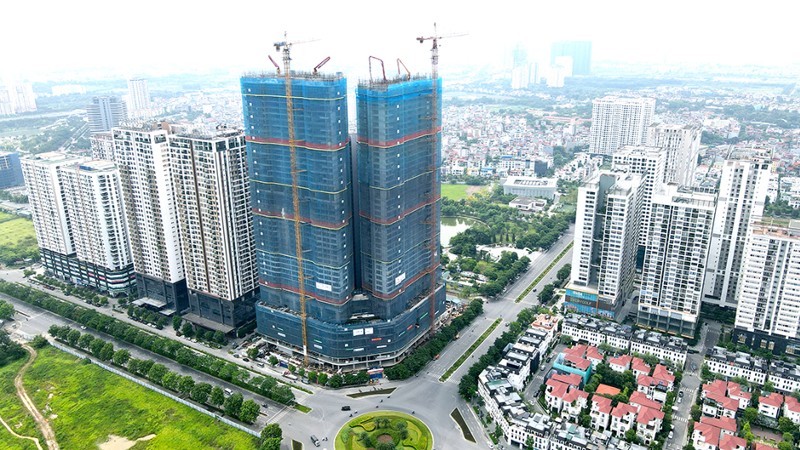The gap between income growth and apartment prices has partly limited the ability of many to buy a house, according to a report from real estate consultants Savills.
The Savills Market Report for the second quarter of 2023 notes that new supply increased 76 per cent quarter-on-quarter and 125 per cent year-on-year, with 3,596 units. The primary stock of 20,412 units was an increase of 5 per cent quarter-on-quarter and 14 per cent year-on-year. There were no new projects in the villa and townhouse market, meanwhile, with only 126 new dwellings coming from two existing projects.
In the second quarter of 2023, primary asking prices of VND53 million ($2,225) per sq m net sellable area (NSA) were an increase of 1 per cent quarter-on-quarter and 17 per cent year-on-year. Primary prices have increased for 18 consecutive quarters and are 73 per cent higher than in the first quarter of 2019.
Ms. Do Thu Hang, Senior Director of Advisory Services at Savills Hanoi said reasons include increasing land and construction costs, infrastructure developments, and quality improvements.
Meanwhile, in the villa and townhouse market, prices in the second quarter of 2023 compared to the previous quarter were adjusted downwards at several villas and shophouses. Primary villa prices fell by 10 per cent quarter-on-quarter to VND100 million ($4,400) per sq m leasable area (LA) with the entry of new affordable products and low-priced inventory in Me Linh district. Shophouse prices decreased by 7 per cent quarter-on-quarter while townhouse prices improved 4 per cent quarter-on-quarter to VND137 million ($6,080) per sq m LA.
Commenting on the mixed situation for low-rise and apartment prices, Ms. Hang said it should be kept in mind that the driver of falling prices in the villa and townhouse market is projects far from the city center being sold at affordable prices and lowering the average price. “Low-rise prices will still stay at a high level, especially in Hanoi,” she added.
Long-term housing demand remains high with positive net migration, population growth and a high urbanization rate. According to the forecast, between 2003 and 2025, Hanoi will have 157,000 new households. However, only 59,000 units in all grades, 9,000 landed properties, and 18,700 social housing units are expected, meaning a shortfall of 70,300 units exists.
Faced with surging demand for house ownership, the question arises as to whether average incomes can enable a person to own a house in Hanoi. The Savills report shows that Hanoi is striving to see per capita annual income of VND150 million ($6,600) in 2023. Compared to 2019, average income growth is 6 per cent per year while apartment price growth from 2019 to the first half of 2023 was 13 per cent per year.
According to Ms. Hang, if such a gap is not narrowed, it will make homeownership more difficult for people in general and particularly for people living in Hanoi or those from other regions who want to have a house in the city. With landed properties, when prices are high, buyers will also consider the reasonableness of the price as well as whether it is consistent with the real value of the asset or not. This will take a longer time for buyers to consider their decisions.
In the villa and townhouse market, dwellings with reasonable prices in well-planned projects still attract buyers. Sales improved in the second quarter of 2023 to 106 dwellings, up by 20 per cent quarter-on-quarter. This is one of the positive signs at the end of the second quarter of 2023 when there are properties with primary prices of VND10 billion ($400,000) per dwelling. In the Hanoi market in the second quarter of 2023, dwellings with primary prices below VND10 billion ($400,000) held a 39 per cent share of sales, while dwellings from VND10 billion to VND20 billion ($800,000) held a 28 per cent share and dwellings of over VND30 billion ($1.2 million) held 13 per cent share.
“The data shows that the more affordable the product, the better the selling rate,” Ms. Hang added.
Primary stock is low, but buyers can still benefit from choosing from the secondary market - with greater choice, reasonable prices, and guaranteed legal compliance. Especially with landed properties, according to Savills, in the second quarter of 2023, secondary products cost 20 per cent less than those in the primary market. There are not so many choices in the primary market, while in the secondary market there are more price options. Though the product is no longer new, in return it is ready to use.
Hanoi has recently accelerated the disbursement of public investment. This is a favorable factor to promote economic activities in the city in general and also other activities, including the real estate business. Construction recently began on Ring Road No. 4, which is expected to boost the development in suburban areas such as Me Linh, Dan Phuong, Hoai Duc, Son Son, Ha Dong, Thanh Oai, and Thanh Tri. When it opens in 2027, residential stock in these areas is forecast to increase by 36 per cent compared to current levels.
Synchronised infrastructure will help attract balanced demand in all areas. With convenient transportation, people with demand will be willing to move to areas with more reasonable prices. This is considered one of the factors resolving the problem of areas in the city center and close to Ring Road No. 3 setting record high prices, which hinder many people’s ability to buy. Areas along Ring Road No. 2 and Ring Road No. 3 have had stable planned social and transport infrastructure and high population density.









 Google translate
Google translate